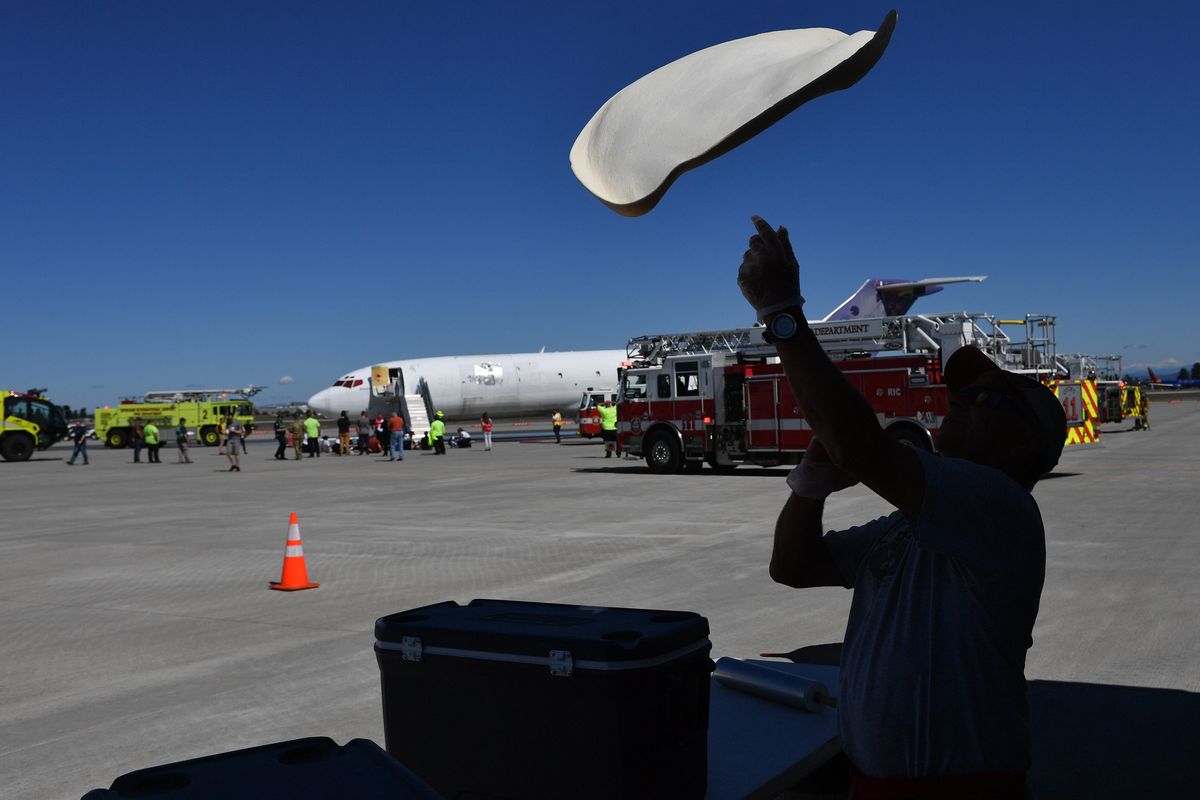‘Hope is not a strategy’: First responders train for mass-casualty event at Spokane International Airport

On Wednesday morning, pretend passengers aboard a decommissioned 727 stumbled onto the tarmac at Spokane International Airport as more than a dozen emergency vehicles responded.
They wheezed and groaned in anguish from the fake wounds they had been given by professional makeup artists earlier that morning.
The scene looked like a real emergency – but that was the whole point, said Todd Woodard, director of marketing and public affairs for Spokane International Airport.
First responders from multiple local agencies gathered at the airport Wednesday for a full-scale emergency exercise, including the airport’s own fire department and aircraft rescue team, the Spokane Fire Department, American Medical Response and first responders from Fairchild Air Force Base. Woodard said the Federal Aviation Administration requires these exercises at least every three years, so airports are prepared for an emergency.
Woodard said the simulation allowed first responders to practice their emergency response to a mass casualty aircraft crash as independent organizations, but also as a coordinated, citywide response.
Spokane Fire Chief Brian Schaeffer said that in the case of an emergency like the one simulated Tuesday, several federal, statewide and city agencies collaborate. First responders respond with urgency, providing medical care and fighting the blazes, while area hospitals coordinate with responders at the scene so they know how many patients to expect.
“We get less than 10 minutes notification with airport crashes or airplane crashes,” Schaeffer said. “It’s definitely a technical and complex incident to prepare our community for, so we do it because it’s a skill that we need to maintain. Every time we do these, we’ve learned something; there’s always something that we can garner out of the experience that will make us better the next time.”
More than 60 volunteers played passengers aboard the plane needing varying levels of care. Each volunteer was given a note card that informed them of their injuries and cognitive state, and were encouraged to use that information to give a believable performance. Woodard said most of the volunteers were employees of the airport and their friends and family members.
Spokane resident Bailey VanderWilde and her classmates in an EMT training program through Providence volunteered to be passengers for the exercise. She said it was good exposure to an emergency she may be responding to one day, even though she was one of the passengers receiving care.
“It’s only our second week, so this is a pretty cool day of class,” VanderWilde said.
The volunteers were loaded onto the plane and emergency vehicles rushed to the scene as if the plane had just landed. EMTs and paramedics evacuated the passengers with minor injuries first, followed by those needing more serious care, who were carried out. Meanwhile, firefighters began running hoses through the emergency exits and around the plane’s body. Woodard said flight attendants are the primary safety officers aboard any given flight, so a retired flight attendant volunteered to help direct first responders as they boarded the plane.
Schaeffer explained that in an emergency triage situation, first responders assess patients immediately to provide care to the most critical first. They use triage tags to sort the patients into different groups: black for those who cannot be saved, red for those in the most critical condition, yellow for those in serious condition and green for those who are minorly wounded and can still walk.
The process of applying fake injuries that look realistic, known as moulage, allows first responders to gain experience seeing and caring for gruesome injuries, Schaeffer said. Volunteers sported fake broken femurs poking out of their blue jeans, head lacerations and open wounds covering the entirety of their backs.
Schaeffer said moulage allows first responders to gain experience seeing the injuries, as well as making split-second decisions on who to care for first. For example, they may come across a patient with a broken femur, and next to that patient may be a 6-year-old with a head injury, starting to seize.
“They have to make a decision, because we make it as real as possible, of which one do we take care of first,” he said. “There’s only one of you, and which one is going to have the highest likelihood for survival with the resources that you have? That’s what triage is really about, and those are tough decisions for providers to make.”
Schaeffer said that it takes the whole community to respond to these situations appropriately. Spokane Public Schools would notify any children of the patients involved in the incident, religious leaders would rally their congregations to support those affected and mental health advocates would step in as well.
“The more profound part is exercising the comprehensive community response, which includes taking care of people from a mental health standpoint, developing a way to reunite them with not only their loved ones, but also their belongings if that’s possible and managing the community’s response to the trauma that will occur across all spectrums,” Schaeffer said. “I hope that it never happens in our community. But hope is not a strategy when it comes to emergency response – and really life in general.”